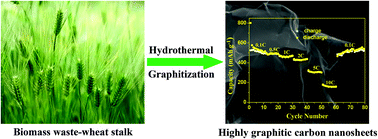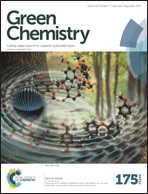Interconnected highly graphitic carbon nanosheets derived from wheat stalk as high performance anode materials for lithium ion batteries†
Abstract
Interconnected highly graphitic carbon nanosheets (HGCNS) have been successfully synthesized via a combined hydrothermal and graphitization process that uses biomass waste (wheat stalk) as the precursor. The as-obtained HGCNS show favorable features for electrochemical energy storage such as high degree of graphitization (up to 90.2%), ultrathin nanosheet frameworks (2–10 atomic layers), graphite-like interlayer spacing (0.3362 nm), and a mesoporous structure. Due to these unique features of HGCNS, they not only can supply multiple sites for the storage and insertion of Li ions, but also can facilitate rapid mass transport of electrons and Li ions. As a result, the HGCNS when used as an anode material for lithium ion batteries show high reversible capacity (502 mA h g−1 at 0.1 C), excellent rate capability (461.4, 429.3, 305.2, and 161.4 mA h g−1 at 1, 2, 5, and 10 C, respectively), and superior cycling performance (215 mA h g−1 at 5 C after 2000 cycles and 139.6 mA h g−1 at 10 C after 3000 cycles). What's more, the relatively flat voltage profiles with a negligible charge/discharge voltage hysteresis of HGCNS would be particularly meaningful for its widespread commercialized application in real lithium ion batteries.


 Please wait while we load your content...
Please wait while we load your content...